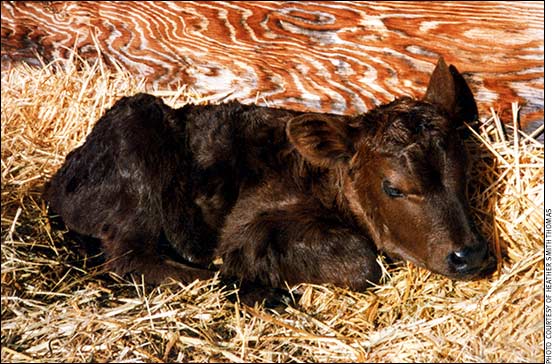
Newborn calves can withstand a lot of cold if they are dry and have a good milk supply.
Cold Stress in Calves
Veterinarian offers tips for preventing, warming chilled calves.
Calves that are severely chilled at birth, without assistance to warm or dry them and to make sure they ingest colostrum in a timely manner, have poor survival rates. If a calf gets too cold before it suckles, it’s hard for the calf to get the teat in its mouth. The calf won’t obtain energy for keeping warm or antibodies to protect it against disease. Its ability to absorb antibodies from colostrum also diminishes as the calf becomes colder.
Producers need to be prepared for cold weather and try to minimize cold stress rather than just try to deal with cold calves, advises Charles Stoltenow, North Dakota State University Extension veterinarian.
“The Number 1 thing is the effect of wind and wet,” he says. Dry cold is not as hard on baby calves as being wet.
Straw or old hay work well to keep calves warm, Stoltenow says. “It’s often better to sacrifice that old hay to keep calves warm rather than thinking you need to feed it to cows.”
Getting the bedding to the calves prior to a weather event — whether cold or moisture — is critical, he warns. “After calves have suffered frostbite, it’s too late. After they’ve been in the rain for three days, it’s too late.”
Calving on pasture in the spring with windbreaks works fairly well, but if you’re in an area where you have to drylot the cows, you must think about windbreaks and cover.
“I’m not a fan of calving barns. They can be warm, but using a barn means we are congregating these animals in what we call a pinch-point in the system,” he says. If it’s warm in the barn, it’s usually humid, possibly leading to pneumonia in young calves.
“If you get a pathogen in there like E. coli, Salmonella, coronavirus or rotavirus, you’re exposing all the calves. If you use calving barns, cleanliness is next to godliness,” he says. Never leave calves in the barn more than 12-24 hours — just long enough to be completely dry and nursing their mothers.
Occasionally a freak storm or extremely cold temperature puts a crimp in the best plans, and you must warm a chilled newborn.
“Calves have been warmed in pickups, garages, bathtubs, et cetera,” Stoltenow says. “Use warm water, not hot. Cold skin is sensitive. You don’t want to burn them, nor rub too much if there’s been frostbite damage.”
The goal is to prevent this type of situation, however, and not have to deal with it. Find a way to break the wind. Newborn calves dry off fast, and if they can get up and nurse before they get too chilled, they do fine. Newborn calves can withstand a lot of cold if they are dry and have a good milk supply.
Colostrum contains energy and helps the calf generate body heat. Even if a calf is cold and becoming lethargic, if you can give it a full feeding of colostrum it can maintain body heat and will have energy to get up and nurse again when it gets hungry.
“The temperature of colostrum is about 101.5 degrees, and that in itself has a warming effect on the calf,” Stoltenow says. “All of those things add up to a resilient animal, if we just give him a chance.”

Editor’s Note: Heather Smith Thomas is a freelancer and cattlewoman from Salmon, Idaho.






